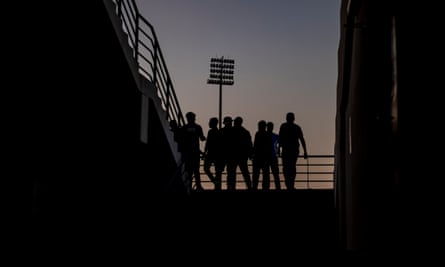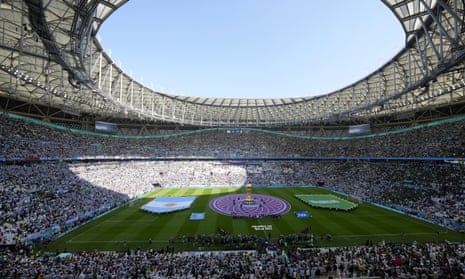The deaths of migrant workers in Qatar in the build-up to this year’s World Cup have drawn criticism across the world. While the tournament’s organizers put the official count at 40, estimates by the Guardian put the figure in the thousands. Here we explore the key questions around an issue that has tarnished the World Cup for many fans.
Why is this World Cup so controversial?
World soccer’s governing body, Fifa, awarded Qatar – a country slightly smaller than Connecticut with scant soccer pedigree – the tournament in December 2010 in a bidding process that, according to American authorities, was riddled with corruption. The shock decision sparked a frenzy of construction in the wealthy nation, which this year became the planet’s biggest exporter of liquefied natural gas.
The high profile of the tournament has drawn attention to Qatar’s dubious human rights record, including its hostility towards LGBT people, and the dangerous and exploitative conditions faced by the vast numbers of migrant workers who have built the infrastructure.
Quick GuideQatar: beyond the football
Show

It was a World Cup like no other. For the last 12 years the Guardian has been reporting on the issues surrounding Qatar 2022, from corruption and human rights abuses to the treatment of migrant workers and discriminatory laws. The best of our journalism is gathered on our dedicated Qatar: Beyond the Football home page for those who want to go deeper into the issues beyond the pitch.
Guardian reporting goes far beyond what happens on the pitch. Support our investigative journalism today.
“Migrant workers were indispensable to making the World Cup 2022 possible, but it has come at great cost for many migrant workers and their families who not only made personal sacrifices, but also faced widespread wage theft, injuries, and thousands of unexplained deaths,” said Rothna Begum, senior researcher at Human Rights Watch.
How many migrant workers are in Qatar and where do they come from?
The population of Qatar is about three million, roughly 88% of whom are foreign citizens. The migrant workforce is estimated at two million, comprising 95% of the labor force. About a million people are employed in construction and another 100,000 are domestic workers. Mostly men, a large percentage come from the Philippines and south Asian countries including India, Pakistan, Nepal and Bangladesh.
What are they building?
The first Middle Eastern country to host the World Cup finals, Qatar has spent anywhere from $220bn-$300bn on infrastructure projects as it uses the globe’s biggest sporting event as a catalyst for nation-building.
At a cost of $6.5bn, Qatar has built seven new stadiums for the tournament and renovated an eighth. Other construction projects have included major upgrades to public transport and roads, and new skyscrapers, hotels and housing, as well as Lusail, a new city that will host the final.
What is the latest death toll?
The official count among workers on World Cup sites is 37 non-work related deaths and only three from work-related accidents but many believe that is a vast undercount.
The problem is that it is hard to associate a firm figure with the tournament and to assess how many deaths were preventable given the lack of available information. Fifa and the Qatari organizers have sought to distance World Cup-related construction from more general projects, though it is likely that many of these would not have been commissioned without the tournament-inspired boom. And they have been on tight deadlines to be ready for the influx of an estimated 1.2 million soccer fans.

Overall, 15,021 non-Qataris died in the country between 2010 and 2019, according to the government. A Guardian analysis in February 2021 found that more than 6,500 migrant workers from India, Pakistan, Nepal, Bangladesh and Sri Lanka had died in Qatar since the award of the tournament. The death records were not categorised by occupation or place of work. The government has said that 30,000 foreign laborers were employed to build World Cup stadiums.
The International Labour Organization (ILO) found that in 2020, 50 people suffered work-related deaths, 500 were seriously injured, and 37,600 sustained mild to moderate injuries.
How are workers dying?
Average high temperatures in Qatar exceed 100F (37.7C) for five months of the year. Though the tournament was moved from summer to winter for the safety and comfort of players, officials and fans, workers are at risk of accidents, heat-related illnesses and other ailments related to the physical and mental strains of working long hours in extreme heat. Suicide is also a concern. Construction workers frequently live in squalid conditions that stand in stark contrast with the opulence of many of the facilities they build.
The Qatari government has argued that “the mortality rate among these communities is within the expected range for the size and demographics of the population.” But statistics show that a large number of young or middle-aged men from Nepal, who would have undergone health checks before being allowed to enter Qatar, have died from heart problems.
Following on from reporting by the Guardian’s Pete Pattisson, an Amnesty International report from 2021 accused Qatar of “routinely [issuing] death certificates for migrant workers without conducting adequate investigations, instead attributing deaths to “natural causes” or vaguely defined “cardiac failures” – making it impossible for bereaved families to claim compensation.
The organization found that as many of 70% of migrant deaths are classified imprecisely, with Guardian data suggesting that 69% of deaths among Indian, Nepali and Bangladeshi workers have been categorised as natural. The ILO report states that falls from height and road traffic accidents were the leading causes of severe injuries.
In 2021 the Guardian highlighted the deaths of workers such as Gangaram Mandal, a laborer from Nepal who came to Qatar in 2018 in order to support his wife and seven daughters. He borrowed money to pay a recruitment fee then earned the equivalent of a dollar a day. After two years he fell ill at the end of a shift during the summer. His death was classed as “heart failure, natural causes”.
What have the Qatari authorities done?
The country has introduced labor law reforms in the past five years, though critics charge that these do not go far enough to protect workers and that enforcement is patchy. “Thousands of workers across all projects are still facing issues such as delayed or unpaid wages, denial of rest days, unsafe working conditions, barriers to changing jobs, and limited access to justice, while the deaths of thousands of workers remain uninvestigated,” according to Amnesty. A minimum wage for all workers equivalent to about $275 a month came into force in 2021.
What have the soccer authorities said?
Teams such as Denmark and the Netherlands have been far more vocal in their criticism of working conditions and human rights than Fifa, which has banned players from wearing “OneLove” rainbow armbands. Shortly before the tournament the Fifa president, Gianni Infantino, urged teams to “focus on the football”.
Infantino later claimed Fifa deserved credit for influencing Qatar to improve standards, including abolishing its abusive “kafala” worker sponsorship system, and said that criticism of the country reeked of Western hypocrisy.
Concerns about LGBT rights, forced labor and unsafe conditions also marred the previous World Cup, in Russia in 2018. A report by the Building and Wood Workers’ International union group found that 21 construction workers died building stadiums in Russia, mostly as a result of falls from heights or being struck by falling equipment.
